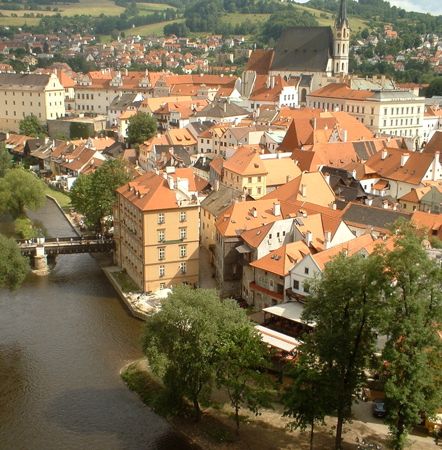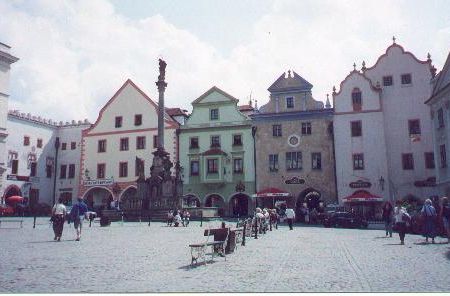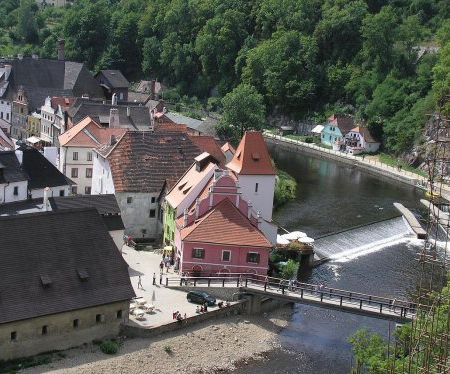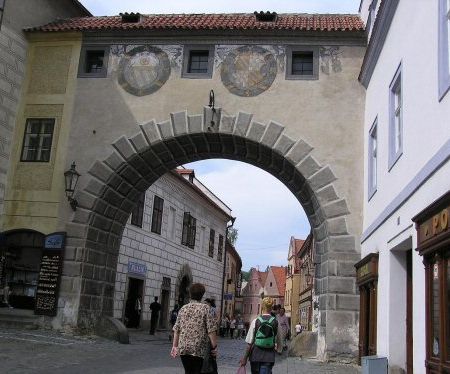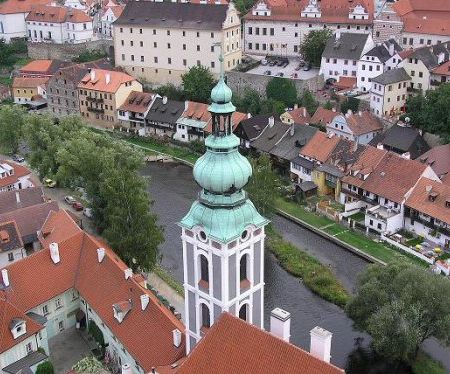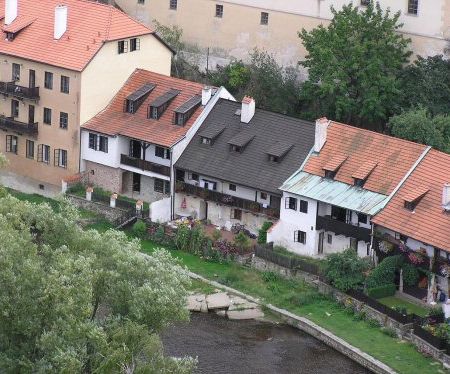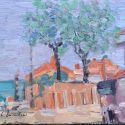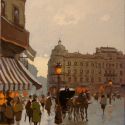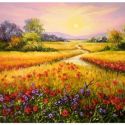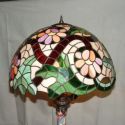According to legend, the name Krumlov is derived from the German Krumme Aue, which may be translated as crooked meadow. The name comes from the natural topography of the town, specifically from the tightly crooked meander of the Vltava river. The word Cesky simply means Czech, or Bohemian, as opposed to Moravian or Silesian. In Latin documents it was called Crumlovia or Crumlovium. The town was first mentioned in documents from 1253, where Krumlov was called Chrumbonowe. The flow of the Vltava River has long been a natural transportation entrance to this region. The area's oldest settlement goes back to the Older Stone Age. Mass settlement was noted in the Bronze Age, Celtic settlements in the Younger Iron Age and Slavonic settlement has been dated as from the 6th century A.D. The Slavs were represented by two tribes - Boletice and Doudleby the family of Witigonen has its origins in Ancient Rome. The family was related to the Roman Ursini family, who is said to have resided on the mountain Mons Rosarum near the city of Rome. After Rome was plundered by the hordes of the Visigoth leader Totila in 546, the family left Rome and one of its members named Vitek (in German, Witigon) travelled together with his wife and child up to the north, passed the Donau (Danube) river and settled in Southern Bohemia. He started a new family there and gradually acquired extensive domains, which he gave to his five sons before his death. Each son received a coat-of-arms with a five-petalled rose, the colour of which symbolized each particular dominion.
In 1251 the Bohemian King Premysl Otakar II gained Austrian lands through marriage to Anna Maria of Bamberg. Premysl Otakar II, with his well-thought out colonization policy, tried to populate the sporadically settled Sumava region in the Czech-Austrian borderland and this way integrate his domains in Bohemia with his newly gained territories in Austria. His efforts however, had its consequences in territories ruled by the sovereign family of Vitkovci, which resulted in particular centres of conflicts with the most powerful aristocratic family in the country. Conflicts had their origins for example in the foundation of the royal town Ceske Budejovice or the Cistercian Monastery Zlata Koruna (Golden crown), both founded by King Premysl Otakar II in 1263. Zlata Koruna was supposed to restrain the influence of the Rosenberg monastery in Vyssi Brod, founded by Peter Wok von Rosenberg in 1259. Frequent disagreements and armed clashes between Premysl Otakar II and members of the particular branches of the Vitkovec family eventually weakened the power of the Bohemian King. In 1302 the Krumlovian branch of the Vitkovci died out and according to the law of escheat their domains should have passed to the king. At that time the Krumlovian estates consisted of a relatively extensive network of castles and smaller subject towns which were sources of numerous incomes for aristocracy. A member of another powerful branch of the Vitkovec family, Jindrich von Rosenberg, asked the king Vaclav II (Wenceslav II) to override the law of escheat and vest the Krumlovian estates to the Rosenbergs. They later made Krumlov the main residence of their family. During the rule of the Rosenberg family, the town as well as the castle flourished. Crafts and trade developed, elaborate homes were built, and the town was endowed with various privileges such as the right to mill, brew beer, hold markets.. Meat shops and breweries were built and twice a year there was a fair. In 1376 there were 96 houses in the town. The family of Eggenbergs died out at the beginning of the 18th century and in 1719 their heirs came to Krumlov. Under the rule of Josef Adam, Cesky Krumlov overcame the imaginary borders of parochialism for the third time and with its high level of architecture and cultural and social events reached the level of the leading aristocratic residences in Central Europe. The aristocratic court and standard of living followed the example set by the Emperor's residence in Vienna. In the 19th century Cesky Krumlov lost its character of an aristocratic residence. Later constructions were not significant. In the mid 19th century the population of the town reached 5,000 inhabitants. A battalion of infantrymen was accommodated there, two comprehensive schools were built, a school of music as well as a so-called work school where children whose parents had died or didn't take care of them were placed. In the town were two breweries, two paper mills, three mills, a flax spinning mill, and a factory for cloth. In the 19th century the architecture of the town also changed its appearance. The town walls were demolished as were all but one of the town gates, Budejovicka. At the end of the 19th century the graphite mines were opened by the castle garden, and a factory for listels and frames as well as a new paper mill in Vetrni began operation. As early as the 19th century, nationality-based problems sometimes broke out between the Czech and German population. After the Declaration of the Czechoslovakian Republic in October 28, 1918, the German population responded with the Declaration of an Independent Sumava Province Bohmerwaldgau which was to become part of a newly constituted Austria. This movement was suppressed by the Czech army and on the 28th of November the region was occupied by Czech forces. |
